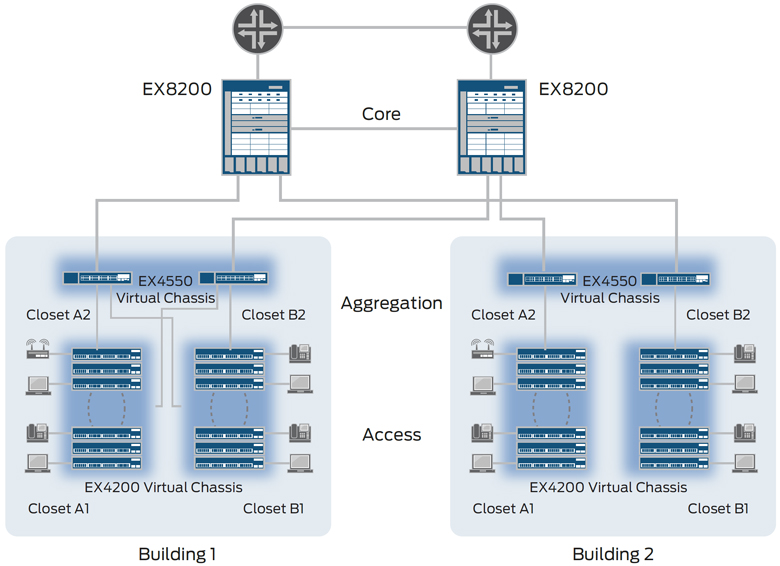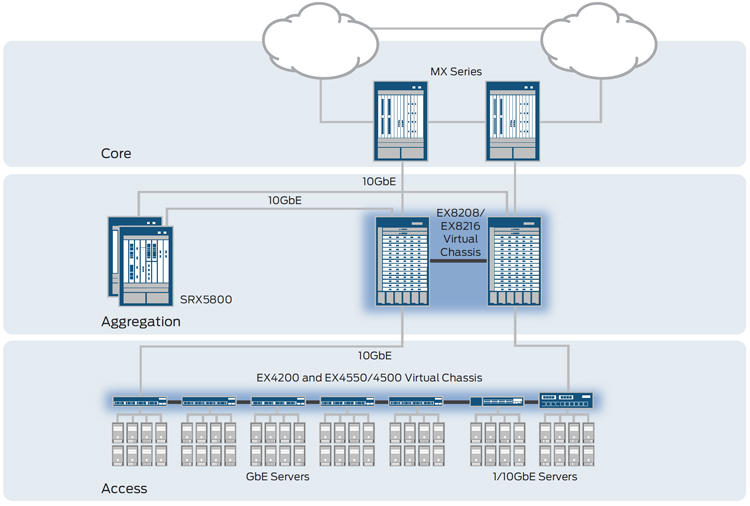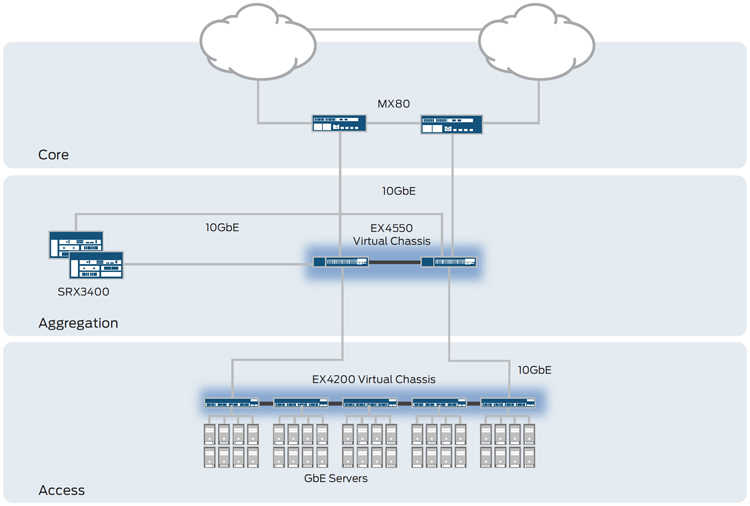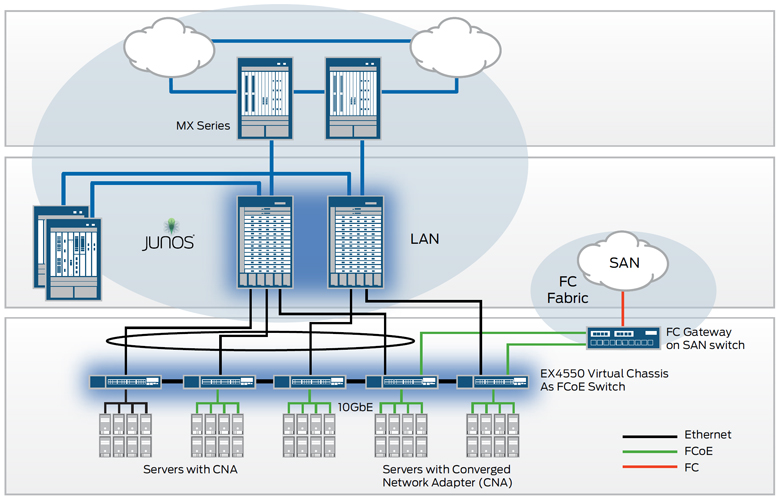
Juniper Networks EX4550-32T Ethernet Switch
32-port 100M/1G/10G BASE-T, converged switch, 650 W AC PS, port side to PSU side airflow or PSU side to port side airflow

Sorry, this product is no longer available, please contact us for a replacement.
More pricing below, click here
EX4500 Overview:
The Juniper Networks EX4550 line of Ethernet switches delivers scalable, high-performance platforms for supporting high-density 10 gigabit per second (Gpbs) data center top-of-rack as well as data center, campus, and service provider aggregation deployments.
Featuring up to 48 wire-speed 1GbE or 10GbE small form-factor pluggable transceiver (SFP/SFP+) or 100M/1GBASE-T/10GBASE-T ports in a compact one rack unit (1 U) platform, the Juniper Networks® EX4550 Ethernet Switch delivers 480 Gbps of Layer 2 and Layer 3 connectivity to networked devices such as servers and other switches. Two versions of the EX4550 base switch are available: a 32-port fiber-based version that provides 32 fixed 10GbE SFP/SFP+ pluggable ports, and a 32-port copper-based* version that supports 32 fixed 100M/1GBASE-T/10GBASE-T ports.
Both versions feature two expansion slots, one in front and one in back, that can accommodate one of four optional expansion modules, providing tremendous configuration and deployment flexibility for campus and data center access and aggregation networks. The four expansion modules include:
- A 128 Gbps Virtual Chassis module
- An 8x10GBASE-T copper expansion module*
- An 8x10GBASE SFP/SFP+ fiber expansion module
- A 2x40GbE expansion module*
Virtual Chassis Technology
The EX4550 supports Juniper Networks' unique Virtual Chassis technology, which enables up to 10 interconnected switches to operate as a single, logical device with a single IP address. Virtual Chassis technology enables enterprises to separate physical topology from logical groupings of endpoints and, as a result, provides efficient resource utilization. The EX4550 can participate in the same Virtual Chassis configuration with any combination of Juniper Networks EX4200 and EX4500 Ethernet Switches, delivering highly flexible and scalable configuration options for campus and data center deployments. EX4550 switches in a Virtual Chassis configuration can be connected using dedicated 128 Gbps interconnect ports on the Virtual Chassis expansion module, or via link aggregation groups (LAGs) across 10GbE/40GbE* ports, providing aggregate backplane capacity of up to 320 Gbps.
In the data center, EX4550 Virtual Chassis deployments can extend across multiple topof- rack or end-of-row switches, providing tremendous configuration flexibility for 10GbE server connectivity by only requiring redundant links between Virtual Chassis groups rather than each physical switch to ensure high availability. In addition, mixed Virtual Chassis configurations featuring EX4200, EX4500, and EX4550 switches provide an ideal solution for data centers with a mix of 1GbE and 10GbE servers, or for environments transitioning from 1GbE to 10GbE server connectivity.
Features & Benefits:
The EX4550 Ethernet switches include the following key features and benefits.
High Performance
Each EX4550 supports 480 Gbps of bandwidth with 48 line-rate 10 Gbps ports at all packet sizes, or 14.88 Mpps per port at the minimum Ethernet frame size.
Security
EX4550 fiber ports (on the base unit or optional expansion module) ship with hardware-capable IEEE802.1AE MACsec ports.
High Availability
EX4550 switches offer dual internal load-sharing AC power supplies and redundant variable-speed fans as standard features, protecting the switch from a single power supply or fan failure. DC power options are also available.
Energy Efficient
Consuming less than eight watts per 10GbE interface, the EX4550 offers a low power solution for 10GbE top-of-rack, end-of-row, and aggregation deployments. The EX4550 switches also improve cooling efficiency with redundant variablespeed fans that automatically adjust their speed based on existing conditions to reduce power consumption.
Small Footprint
The EX4550 supports up to 48 wire-speed 10GbE ports in a single 1 U platform.
Junos Operating System
The EX4550 runs the same Juniper Networks Junos operating system that is used by other EX Series Ethernet Switches, as well as all Juniper Networks routers and Juniper Networks SRX Series Services Gateways. By utilizing a common operating system, Juniper Networks delivers a consistent implementation and operation of control plane features across all products. To maintain that consistency, Junos OS adheres to a highly disciplined development process that uses a single source code, follows a single quarterly release train, and employs a highly available modular architecture that prevents isolated failures from bringing down an entire system.
These attributes are fundamental to the core value of the software, enabling all Junos OS-powered products to be updated simultaneously with the same software release. All features are fully regression tested, making each new release a true superset of the previous version; customers can deploy the software with complete confidence that all existing capabilities will be maintained and operate in the same way.

Junos OS utilizes a single source code, adheres to a consistent and predictable release train, and employs a single modular architecture.
Management Options
Up to four different system management options are available for the EX4550 Ethernet switches.
- The standard Junos OS command-line interface (CLI) offers the same granular management capabilities and scripting parameters found in any router powered by the Junos OS.
- The EX4550 also includes the integrated Juniper Networks J-Web Software, an embedded web-based device manager that allows users to configure, monitor, troubleshoot, and perform system maintenance on individual switches via a browserbased graphical interface.
- EX4550 performance, configuration, and fault data can also be exported to leading third-party management systems such as HP OpenView, IBM Tivoli, and Computer Associates Unicenter software, providing a complete, consolidated view of network operations.
- The EX4550 is also supported by Juniper Networks Junos® Space*, an open, programmable application platform for hosting a comprehensive suite of network operational application tools that provide a smart, simple, and open approach for automating the deployment and operation of a Juniper infrastructure.
Explicitly designed to allow partners and customers to build and deploy smart, simple, and easy-to-use applications, Junos Space provides multiple management and infrastructure applications for managing Juniper resources and assets, including inventory management, device and interface configuration, automated software management and deployment, and event-driven fault management. These Junos Space applications offer predefined automation schemes and best practice templates to enable rapid and accurate deployments.
Additional Features
- System status LEDs
- LCD status display
- Versatile two- and four-post rack mounting options
- Front-to-back and back-to-front airflow options
- AC and DC power supply options
- Support for Jumbo frames (9,000)
- Quality of service (IEEE 802.1p marking)
- Multicast (Internet Group Management Protocol v1/v2/v3 snooping)
- Layer 2 features including support for 4,096 VLAN IDs, Spanning Tree (802.1s and 802.1w), bridge protocol data unit (BPDU) guard, 802.3as Link Aggregation
- Management features including Telnet and SSH v1/v2, SNMP v1-v3, RADIUS, TACACS+, and RMON
Data Center and Campus Advantages:
The EX4550 delivers a highly available, simple, and scalable 10GbE connectivity solution in a compact and power efficient platform, making it a perfect fit for both data center and campus networks. The EX4550 offers a number of other advantages for
Simple
Virtual Chassis technology on the EX4550 dramatically simplifies the campus aggregation layer, eliminating the need for Spanning Tree Protocol (STP), Virtual Router Redundancy Protocol (VRRP), complex routing, or VLAN configurations. In addition, when deployed in a Virtual Chassis configuration, the EX4550 also reduces the number of devices to manage and can even eliminate network switching layers. A single Virtual Chassis configuration can span multiple nodes, reducing the need for larger, more expensive nodes on superior tiers. Juniper Networks Junos® operating system, which is common across the entire EX Series switch product family, accelerates the learning curve by enabling the entire architecture to be managed with a common set of
Scalable
A single EX4550 can support up to 48 10GbE ports at line rate, providing a highly scalable solution for even the most demanding environments. In addition, Virtual Chassis technology makes it easy to scale the network while reducing management complexity
By adding switches to a Virtual Chassis configuration, it is possible to grow the number of switch ports without increasing the number of devices to manage. As more switches are added to the Virtual Chassis configuration, backplane bandwidth demands can also be scaled to maintain adequate oversubscription ratios. EX4550 Virtual Chassis bandwidth can be increased to 256 Gbps by inserting 128 Gbps Virtual Chassis expansion modules in each of the two available expansion slots.
Highly Available
When EX4550 switches are deployed in a Virtual Chassis configuration, Junos OS initiates a process to assign a master (active) and backup (hot standby) switch to manage the configuration. If the master switch fails, an integrated Layer 2 and Layer 3 graceful Routing Engine switchover (GRES) feature automatically switches to the backup to maintain continuous and uninterrupted system operations. The EX4550 switch also includes a number of other high availability features, including redundant power and cooling, graceful protocol restart, equal-cost multipath (ECMP), LAG links distributed across multiple slots, and quality of service (QoS) to prioritize time-sensitive data.
Adaptable and Modular
As business grows, the network needs to evolve. With its compact 1 U form factor and complete switch features, the EX4550 can be easily redeployed in different environments and physical layouts. For customers with fiber port requirements, the dualspeed interfaces on the EX4550 enable an easy transition from 1GbE to 10GbE. EX4550 switch capacity can be expanded without increasing the number of managed devices by simply adding more switches to the Virtual Chassis configuration.
Network Deployments:
Campus Deployments
The EX4550 offers an economical, power efficient and compact solution for aggregating 10GbE expansions from access devices in building and campus deployments (see Figure 1). The switch's dualspeed interfaces also support environments transitioning from 1GbE to 10GbE.
The EX4550 easily meets enterprise core switch requirements, delivering wire-speed performance on every port, full device redundancy, support for Layer 3 dynamic routing protocols such as RIP and OSPF, L2 and L3 MPLS VPNs, and a comprehensive security and QoS feature set.
Data Center Deployments
The EX4550 Ethernet Switch is designed for demanding data center applications where high performance, high availability, and energy efficiency are key requirements (see Figure 2). Operating at wire speed, the EX4550 switches deliver 714 Mpps throughput and a data rate of 960 Gbps (full duplex) for both Layer 2 and Layer 3 protocols. EX4550 switches can be interconnected in a Virtual Chassis configuration that also includes EX4200 and EX4500 switches, creating a single logical device that offers a variety of port and density options for mixed server environments.
Flexible deployment options enable the EX4550 to support back-to-front and front-to-back cooling, which ensures consistency with server designs for hot and cold aisle deployments. Front and rear facing configuration options ensure closer proximity to server ports, optimizing performance and keeping cable lengths short and manageable. The EX4550 is also very environmentally conscious, drawing less than eight watts per port under maximum load.
For small data centers, the EX4550, when deployed in a Virtual Chassis configuration, is ideally suited as an aggregation/core switch, aggregating 10GbE expansions from EX4200 Virtual Chassis configurations in the access layer (see Figure 3).
Customers introducing 10GbE into their server racks can use the EX4550 to add 10GbE-attached servers, iSCSI, and networkattached storage (NAS) with minimal impact to the current switching infrastructure.

Figure 1: The EX4550 offers an economical, power-efficient, compact solution for campus aggregation deployments.

Figure 2: The EX4550 provides 10GbE server access in the data center.

Figure 3: The EX4500 10GbE switch is ideal for small data center core deployments.
10GbE Data Center Bridging and I/O Convergence Deployments
The EX4550 is a full IEEE DCB- and T11 FC-BB-5-based Fibre Channel over Ethernet (FCoE) transit switch, delivering a high-performance solution for converged server edge access environments. As an FCoE transit switch, the EX4550 provides a pure IEEE DCB converged access layer between FCoE-enabled servers and an FCoE-enabled Fibre Channel storage area network (SAN) (see Figure 4).
The EX4550 also supports FC Initiation Protocol (FIP) snooping, which provides perimeter protection to ensure that the presence of an Ethernet layer does not impact existing SAN security policies. The FCoE transit switch functionality, along with prioritybased flow control (PFC) and Data Center Bridging Capability Exchange protocol (DCBX), are included as part of the default software; no additional licenses are required.

Figure 4: The EX4550 deployed as a data center FCoE transit switch in a top-of-rack Virtual Chassis configuration.
Technical Specifications:
| Model: | EX4550 Series |
|---|---|
| Physical Specifications | |
| Form Factor | Fixed platform |
| Backplane | Up to 256 Gbps (Virtual Chassis) |
| Dimensions (W x H x D) | 17.3 in x 1.7 in x 18.5 in (43.8 cm x 4.4 cm x 47.0 cm) |
| Weight | 19.4 lb (8.8 kg) with one AC and DC power supply |
| Rack mountable | 1 Rack Units |
| Hardware Specifications | |
| Interface Options |
|
| CPU | 1.2 GHz |
| Data Rate | 960 Gbps (full duplex) |
| Throughput | 714 Mpps |
| 10/100/1000BASE-T Port Densities | 32 1000BASE-T ports in base unit (48 total with optional expansion modules) via copper SFP optics |
| 100BASE-FX / 1000BASE-X (SFP) Port Densities | 1000BASE-X SFP/SFP+ ports in base unit; 48 total with optional expansion modules |
| 10GBASE-X Port Densities | 32 in base unit; 48 total with optional uplink modules |
| Resiliency | Dual internal load sharing AC and DC power supplies (optional); redundant variable-speed fans |
| Operating System | Junos |
| Traffic Monitoring | sFlow (roadmap) |
| QoS Queues / Port | 8 |
| MAC Addresses | 32,000 |
| Jumbo Frames | 9,216 bytes |
| IPv4 Unicast / Multicast Routes | 10,000 / 4,000 |
| Number of VLANs | 4,096 |
| ARP Entries | 8,000 |
| LEDs | System LEDs that indicate status |
| Power Options | |
| Power Supplies | 650 W AC and DC power supplies |
| Environment | |
| Operating Temperature | 32° to 113° F (0º to 45º C) |
| Storage Temperature | -40º to 158º F (-40º to 70º C) |
| Relative Humidity (Operating) | 10% to 85% (noncondensing) |
| Relative Humidity (Non-Operating) | 0% to 95% (noncondensing) |
| Altitude (Operating) | Up to 10,000 ft (3,048 m) |
| Altitude (Non-Operating) | Up to 16,000 ft (4,877 m) |
| Airflow |
|
| Safety and Compliance | |
| Safety Certifications |
|
| Electromagnetic Compatibility Certifications |
|
| Environmental | Reduction of Hazardous Substances (ROHS) 5 |
| Telco | CLEI code |
| Telecom Quality Management | TL9000 |
Additional Feature Specifications:
- RADIUS
- TACACS+
- Access control lists (ACLs): Allow and deny
- SSH v1, v2
- Secure interface login and password
- Local proxy Address Resolution Protocol (ARP)
- Static ARP support
Layer 2 Switching
- Maximum number of media access control (MAC) addresses in hardware: 32,000
- Jumbo frames: 9,216 bytes
- Number of VLANs: 4,096
- Port-based VLAN
- 4,096 VLAN IDs supported
- Routed VLAN interface (RVI)
Link Aggregation
- 802.3ad support
- Number of LAGs supported: 64
- Maximum number of ports per LAG: 8
- LAG load-sharing algorithm—bridged or routed (unicast or multicast) traffic:
- IP: S/D IP
- TCP/UDP: S/D IP, S/D Port
- Non-IP: S/D MAC
- Tagged ports support in LAG
Spanning Tree
- Rapid Spanning Tree Protocol (RSTP) and VLAN Spanning Tree Protocol (VSTP) running concurrently
- Spanning Tree Protocol (802.1D)
- Multiple Spanning Tree Protocol (MSTP) (802.1s)
- RSTP (802.1w)
- VSTP - VLAN Spanning Tree
- BPDU protect
- Loop protect
- Root protect
Quality of Service
- EZQoS
- Class of service (CoS) on L3 VLAN
- Per interface rewrite
- Per interface classification
- Policer mark down action
- Remarking of bridged packets
- Layer 2 QoS
- Layer 3 QoS
- Rate Limiting:
- Ingress policing: 1 rate 2 color
- Egress shaping: Per queue, per port
- 8 hardware queues per port
- Scheduling methods (egress): Strict priority (SP), shapeddeficit weighted round-robin (SDWRR)
- 802.1p remarking
- L2-L4 classification criteria: Interface, MAC address, Ethertype, 802.1p, VLAN, IP address, DiffServ code point (DSCP)/IP precedence, TCP/UDP port numbers, etc.
- Congestion avoidance capabilities: Weighted tail drop eight queues
Layer 3 Features: IPv4
- VRF-lite (ISIS, RIP, OSPF, BGP, BGP, ISIS)
- IP directed broadcast traffic forwarding
- Routing protocols: RIPv1/v2, OSPF, BGP, ISIS
- Max number of IPv4 unicast routes in hardware: 10,000
- Max number of IPv4 multicast routes in hardware: 4,000
- Static routing
- Routing policy
- Virtual Router Redundancy Protocol (VRRP)
- Bidirectional Forwarding Detection (BFD) protocol
Layer 3 Features: IPv6
- Max number of Neighbor Discovery (ND) entries: 1,000
- Max number of IPv6 unicast routes in hardware: 1,000
- Max number of IPv6 multicast routes in hardware: 1,000
- Routing protocols: RIPng, OSPFv3, IPv6, BGP, MLDv2
- Static routing
Multicast
- VRF-lite (PIM, IGMP)
- IGMP static
- IGMP v1, v2, v3
- IGMP snooping
- Protocol Independent Multicast–Sparse Mode (PIM-SM), and PIM source-specific multicast (PIM-SSM)
- Multicast Source Discovery Protocol (MSDP)
Access Control Lists (ACLs) (JUNOS Software firewall filters)
- Port-based ACL (PACL): Ingress and egress
- VLAN-based ACL (VACL): Ingress and egress
- Router-based ACL (RACL): Ingress and egress
- ACL entries (ACE) in hardware per system: 1,500
- ACL counter for denied packets
- ACL counter for permitted packets
- Ability to add/remove/change ACL entries in middle of list (ACL editing)
- L2-L4 ACL
- Trusted Network Connect (TNC) certified
- MAC authentication (RADIUS)
- Control plane denial-of-service (DoS) protection
Virtual Chassis Capabilities
- Maximum number of members: 10
- Virtual Chassis ports (VCPs):
- Two dedicated 64 Gbps ports with 128 Gbps Virtual Chassis module
- Any base or expansion port can act as a VCP
- Two dedicated 64 Gbps ports with 128 Gbps Virtual Chassis module
- Maximum Virtual Chassis interconnect capacity:
- 128 Gbps with Virtual Chassis module
- Up to 48 x 10 Gbps using base or expansion ports (subject to a maximum of 8 members per LAG group per destination, 64 LAG groups per system)
- 128 Gbps with Virtual Chassis module
- Maximum Virtual Chassis distance:
- Virtual Chassis module ports: Up to 7 m with VCP cable
- Base or expansion ports: Up to maximum distance supported by optics
- Virtual Chassis module ports: Up to 7 m with VCP cable
Data Center Bridging (DCB)
- Priority-based flow control (PFC): IEEE 802.1Qbb
- Data Center Bridging Capability Exchange protocol (DCBX)
Fibre Channel over Ethernet (FCoE)
- FCoE transit switch (FIP snooping)
- iSCI SAN
- iSCI TLV support
- Nonstop active routing (NSR): OSPF v2, RIP v1/v2, BGP, IS-IS, IGMP v1, v2, v3
- Redundant, hot-swappable power supplies
- Redundant, field-replaceable, hot-swappable fans
- GRES for Layer 2 hitless forwarding and Layer 3 protocols on Routing Engine failover
- Graceful restart: OSPF, BGP, IGMP v1/v2/v3 snooping
- Nonstop bridging for xSTP, Link Aggregation Control Protocol (LACP), Link Layer Discovery Protocol–Media Endpoint Discovery (LLDP/LLDP-MED)
- Nonstop software upgrade (NSSU) for EX4550 with Virtual Chassis or EX4200/EX4550/EX4500 with Virtual Chassis
- Virtual Chassis fast convergence (as low as sub-50 ms)
MPLS
- The following MPLS functionality is supported on EX4550 switches:
- Label-switching router (LSR) and label edge router (LER) functionality
- R SVP and LDP for label assignment and distribution (LSP setup), and BGP for advertising label-switched paths (LSPs)
- Traffic protection through standby secondary paths
- Traffic-engineering capabilities provided by OSPF, IS-IS, Constrained Shortest Path First (CSPF), and RSVP-TE
- Static LSPs
- IPv4 over MPLS, IPv6 tunneling
- BGP-based L2 VPNs
- LDP-based L2 circuits
- L3 VPNs for IPv4 and IPv6 unicast traffic
- Circuit cross-connect (CCC)
Supported RFCs
- RFC 2925 MIB for Remote Ping, Trace
- RFC 1122 Host Requirements
- RFC 768 UDP
- RFC 791 IP
- RFC 783 Trivial File Transfer Protocol (TFTP)
- RFC 792 ICMP
- RFC 793 TCP
- RFC 826 ARP
- RFC 894 IP over Ethernet
- RFC 903 RARP
- RFC 906 TFTP Bootstrap
- RFC 1027 Proxy ARP
- RFC 2068 HTTP server
- RFC 1812 Requirements for IP Version 4 Routers
- RFC 1519 Classless Interdomain Routing (CIDR)
- RFC 1256 IPv4 ICMP Router Discovery (IRDP)
- RFC 1058 RIP v1
- RFC 2453 RIP v2
- RFC 1112 IGMP v1
- RFC 2236 IGMP v2
- RFC 3618 MSDP
- RFC 4915 MT-OSPF
- RFC 3376 IGMP v3
- RFC 1492 TACACS+
- RFC 2138 RADIUS Authentication
- RFC 2139 RADIUS Accounting
- RFC 3579 RADIUS EAP support for 802.1x
- RFC 5176 Dynamic Authorization Extensions to RADIUS
- RFC 2267 Network Ingress Filtering
- RFC 2030 SNTP, Simple Network Time Protocol
- RFC 854 Telnet client and server
- RFC 951, 1542 BootP
- RFC 2131 BOOTP/DHCP relay agent and Dynamic Host Configuration Protocol (DHCP) server
- RFC 1591 Domain Name System (DNS)
- RFC 2338 VRRP
- RFC 2328 OSPF v2 (edge mode)
- RFC 1587 OSPF not-so-stubby area (NSSA) Option
- RFC 2154 OSPF w/Digital Signatures (Password, MD-5)
- RFC 2370 OSPF Opaque link-state advertisement (LSA) Option
- RFC 3623 OSPF Graceful Restart
- RFC 2362 PIM-SM (edge mode)
- RFC 3569 draft-ietf-ssm-arch-06.txt PIM-SSM PIM Source Specific Multicast
- RFC 2474 DiffServ Precedence, including 8 queues/port
- RFC 2598 DiffServ Expedited Forwarding (EF)
- RFC 2597 DiffServ Assured Forwarding (AF)
- RFC 2475 DiffServ Core and Edge Router Functions
- FC 4364 BGP/MPLS IP Virtual Private Networks
- LLDP Media Endpoint Discovery (LLDP-MED), ANSI/TIA-1057, draft 08
- PIM-DM Draft IETF PIM Dense Mode draft-ietf-idmr-pimdm- 05.txt, draft-ietf-pim-dm-new-v2-04.txt
- Draft-ietf-bfd-base-05.txt Bidirectional Forwarding Detection
Supported MIBs
- FC 1155 SMI
- RFC 1157 SNMPv1
- RFC 1905 RFC 1907 SNMP v2c, SMIv2, and Revised MIB-II
- RFC 2570 – 2575 SNMPv3, user based security, encryption, and authentication
- RFC 2576 Coexistence between SNMP Version 1, Version 2, and Version 3
- RFC 1212, RFC 1213, RFC 1215 MIB-II, Ethernet-like MIB, and TRAPs
- RFC 2578 SNMP Structure of Management Information MIB
- RFC 2579 SNMP Textual Conventions for SMIv2
- RFC 2925 Ping/Traceroute MIB
- RFC 2665 Ethernet-like interface MIB
- RFC 1643 Ethernet MIB
- RFC 1493 Bridge MIB
- RFC 2096 IPv4 Forwarding Table MIB
- RFC 2011 SNMPv2 for Internet protocol using SMIv2
- RFC 2012 SNMPv2 for transmission control protocol using SMIv2
- RFC 2013 SNMPv2 for user datagram protocol using SMIv2
- RFC 2863 Interface MIB
- RFC 3413 SNMP Application MIB
- RFC 3414 User-based Security Model for SNMPv3
- RFC 3415 View-based Access Control Model for SNMP
- RFC 1724 RIPv2 MIB
- RFC 2863 Interface Group MIB
- RFC 2932 IPv4 Multicast MIB
- RFC 2787 VRRP MIB
- RFC 1850 OSPFv2 MIB
- RFC 2819 RMON MIB
- RFC 2287 System Application Packages MIB
- RFC 4188 STP and Extensions MIB
- RFC 4363 Definitions of Managed Objects for Bridges with Traffic Classes, Multicast Filtering, and VLAN extensions
- RFC 2922 LLDP MIB
- Draft – blumenthal – aes – usm - 08
- Draft – reeder - snmpv3 – usm - 3desede -00
- Draft – ietf-idmr-igmp-mib-13
- Draft – ietf-idmr-pim-mib-09
- Draft – ietf-bfd-mib-02.txt
Troubleshooting
- Debugging: CLI via console, Telnet, or SSH
- Diagnostics: Show and debug command, statistics
- Traffic monitoring/mirroring (port, VLAN)
- IP tools: Extended ping and trace
- Junos OS commit and rollback
Traffic Mirroring
- Static LSPs
- Port-based
- VLAN-based
- ACL-based mirroring
- Mirroring destination ports per system: 1
- LAG port monitoring
- Multiple destination ports monitored to 1 mirror (N:1)
- Maximum number of mirroring sessions: 1
- Mirroring to remote destination (over L2): 1 destination VLAN
Documentation:
Download the Juniper Networks EX4550 Ethernet Switches Datasheet(PDF).
Pricing Notes:
- Pricing and product availability subject to change without notice.
List Price:
Our Price: $91.77
List Price:
Our Price: $107.07
List Price:
Our Price: $146.51
List Price:
Our Price: $208.50
List Price:
Our Price: $61.99
